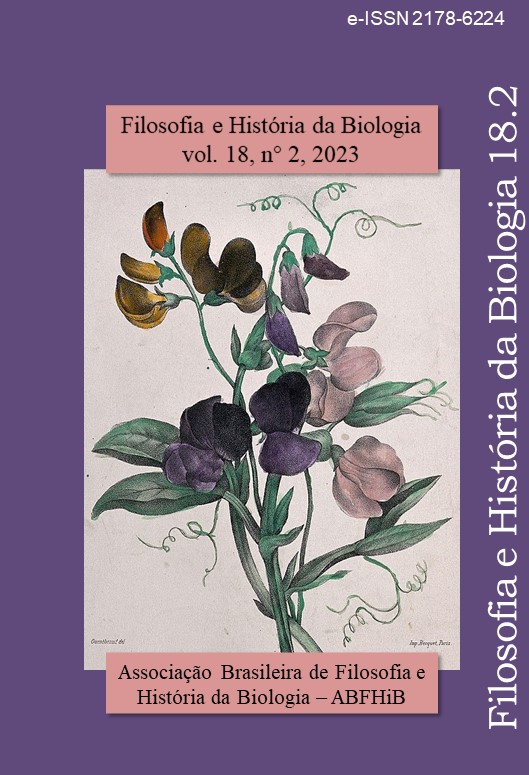Relationship between transmission genetics and molecular genetics: How does contemporary biology interpret Gregor Mendel’s dominant and recessive characters?
DOI:
https://doi.org/10.11606/issn.2178-6224v18i2p111-126Keywords:
History of genetics, Dominance, Recessiveness, Scientific explanationsAbstract
A biochemical explanation of dominance allows the reinterpretation of the phenomenon and the relationship between transmission and molecular genetics. This work discusses the explanations of dominance and recessiveness based on Mendel’s proposal and how contemporary molecular genetics contribute. For this reason, we will consider some authors who, in the 20th century, tried to explain the phenomenon as aspects referring to the articulation between the genetics of transmission and molecular genetics in the interpretation of dominance. The article will try to explain the dominance on two levels, the phenotypic (originally by Mendel) and the molecular, aiming to show that, based on the epistemological approach, they do not deal with the same phenomenon but only with different and historically mixed facts.
References
ARMSTEAD, Ian; DONNISON, Iain; AUBRY, Sylvain; HARPER, John; HÖRTENSTEINER, Stefan; JAMES, Caron; MANI, Jan; MOFFET, Matt; OUGHAM, Helen; ROBERTS, Luned; THOMAS, Ann; WEEDEN, Norman; THOMAS, Howard; KING, Ian. Cross species identification of Mendel’s I locus. Science, 315 (5808): 73-73, 2007. Disponível em: https://doi.org10.1126/science.1132912.
BATESON, William; SAUNDERS, Edith Rebecca. The facts of heredity in the light of Mendel’s discovery. Reports to the Evolution Committee of the Royal Society, 1: 125-160, 1902. Disponível em: http://v3r.esp.org/foundations/genetics/classical/holdings/b/wb-02b.pdf. Acesso em 20 julho 2023.
BEADLE, George W.; TATUM, Edward L. Genetic control of biochemical reactions in Neurospora. Proceedings of the National Academy of Sciences, 27 (11): 499-506, 1941a. Disponível em: https://doi.org/10.1073/pnas.27.11.499.
BEADLE, George W.; TATUM, Edward L. Genetic control of developmental reactions. The American Naturalist, 75 (757): 107-116, 1941b. Disponível em: https://www.journals.uchicago.edu/doi/abs/10.1086/280939?journalCode=an. Acesso em 20 julho 2023.
CORRENS, Carl. [1900]. Mendel’s law concerning the behavior of progeny of varietal hybrids. Trad. Leonie Kellen Piernick. Reproduzido em: Genetics, 35 (5): 33-41, 1950. Disponível em: http://www.esp.org/foundations/genetics/classical/holdings/c/cc-00.pdf. Acesso em 19 julho 2023.
DE VRIES, Hugo. [1900]. Concerning the law of segregation of hybrids. Trad. Aloha Hannah. Genetics, 35 (5): 30-32, 1950. Disponível em http://v3r.esp.org/foundations/genetics/classical/holdings/v/hdv-00.pdf. Acesso em 19 julho 2023.
DURIGAN, Larissa Nunes; MARTINS, Lilian Al-Chueyr Pereira. Revisitando a história da genética clássica: dos caracteres unitários aos genes. Filosofia e História da Biologia, 16 (2): 209-236, 2021. Disponível em: https://doi.org/10.11606/issn.2178-6224v16i2p209-236.
ELLIS, TH Noel; HOFER, Julie M. I.; TIMMERMAN-VAUGHAN, Gail M.; COYNE, Clarice J.; HELLENS, Roger P. Mendel, 150 years on. Trends in Plant Science, 16 (11): 590-596, 2011. Disponível em: https://doi.org/10.1016/j.tplants.2011.06.006.
FALK, Raphael. The rise and fall of dominance. Biology and Philosophy, 16 (3): 285-323, 2001. Disponível em: https://doi.org/10.1023/A:1010611605295.
GRIFFITHS, Anthony J.; WESSLER, Susan R.; LEWONTIN, Richard C.; GELBART, William M.; SUZUKI, David T.; MILLER, Jeffrey H. Introdução à genética. 9ª edição. Trad. Paulo A. Motta. Rio de Janeiro: Guanabara Koogan, 2011.
HEDDEN, Peter; PROEBSTING, William M. Genetic analysis of gibberellin biosynthesis. Plant Physiology, 119 (2): 365-370,
Disponível em: https://doi.org/10.1104/pp.119.2.365.
Hull, David L. Philosophy of biological science. New Jersey: Prentice-Hall, Englewood Cliffs, 1974.
HULL, David L. Filosofia da ciência biológica. Trad. Eduardo de Almeida. Rio de Janeiro: Zahar Editores, 1975.
KACSER, Henrik; BURNS, James A. The molecular basis of dominance. Genetics, 97 (3-4): 639-666, 1981. Disponível em: https://doi.org/10.1093/genetics/97.3-4.639.
MARTINS, Lilian A.-C. P. Bateson e o programa de pesquisa mendeliano. Episteme. Filosofia e História da Ciência em Revista, (14): 27-55, 2002.
MENDEL, Gregor. [1866] Experiments in plant hybridisation. New York: Cosimo Classics. [1909] 2008.
OFFNER, Susan. Mendel’s peas & the nature of the gene: genes code for proteins & proteins determine phenotype. The American Biology Teacher, 73 (7): 382-387, 2011. Disponível em: https://doi.org/10.1525/abt.2011.73.7.3.
PIERCE, Benjamin A. Genetics: a conceptual approach. 5th edition. New York: W. H. Freeman & Company, 2014.
PUNNETT, Reginal Crundall; BATESON, William. The heredity of sex. Science, 27 (69): 785-787, 1908. Disponível em: https://doi.org/10.1126/science.27.698.785.
REECE, Jane B; URRY, Lisa A.; CAIN, Michael L.; WASSERMAN, Steven A.; MINORSKY, Peter V.; JACKSON, Robert B. Biologia de Campbell. Tradução Anne D. Villela et al. 10. ed., Porto Alegre: Artmed, 2015.
REID, James B.; ROSS, John J. Mendel’s genes: toward a full molecular characterization. Genetics, 189 (1): 3-10, 2011. Disponível em: https://doi.org/10.1534/genetics.111.132118.
STUBBE, Hans. History of genetics: from prehistoric times to the rediscovery of Mendel’ laws. Trad. T.R.W. Waters. Cambridge, MA: MIT Presss, 1972.
THOMAS, H.; SCHELLENB.ERG, M.; VICENTINI, F; MATILE, Ph. Gregor Mendel's green and yellow pea seeds. Botanica Acta, 109 (1): 3-4, 1996. Disponível em: https://doi.org/10.1111/j.1438-8677.1996.tb00862.x
WRIGHT, Sewall. Physiological and evolutionary theories of dominance. The American Naturalist, 68 (714): 24-53, 1934. Disponível em: https://www.journals.uchicago.edu/doi/abs/10.1086/280521. Acesso em 17 julho 2023.

Downloads
Published
Issue
Section
License
Copyright (c) 2023 Filosofia e História da Biologia

This work is licensed under a Creative Commons Attribution-NonCommercial-ShareAlike 4.0 International License.
The published manuscripts become the property of the journal Philosophy and History of Biology, and the authors accept the terms of this license and agree to assign the copyright for publication, in addition to agreeing with the publication's commitment to offering open access to all of its content. The information and concepts issued in signed papers are the sole responsibility of their authors.

 cademia.edu
cademia.edu
